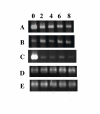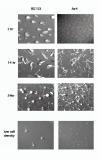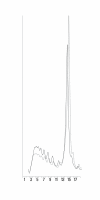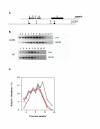IfkA, a presumptive eIF2 alpha kinase of Dictyostelium, is required for proper timing of aggregation and regulation of mound size
- PMID: 12697064
- PMCID: PMC154100
- DOI: 10.1186/1471-213x-3-3
IfkA, a presumptive eIF2 alpha kinase of Dictyostelium, is required for proper timing of aggregation and regulation of mound size
Abstract
Background: The transition from growth to development in Dictyostelium is initiated by amino acid starvation of growing amobae. In other eukaryotes, a key sensor of amino acid starvation and mediator of the resulting physiological responses is the GCN2 protein, an eIF2alpha kinase. GCN2 downregulates the initiation of translation of bulk mRNA and enhances translation of specific mRNAs by phosphorylating the translation initiation factor eIF2alpha. Two eIF2alpha kinases were identified in Dictyostelium and studied herein.
Results: Neither of the eIF2alpha kinases appeared to be involved in sensing amino acid starvation to initiate development. However, one of the kinases, IfkA, was shown to phosphorylate eIF2alpha from 1 to 7 hours after the onset of development, resulting in a shift from polysomes to free ribosomes for bulk mRNA. In the absence of the eIF2alpha phosphorylation, ifkA null cells aggregated earlier than normal and formed mounds and ultimately fruiting bodies that were larger than normal. The early aggregation phenotype in ifkA null cells reflected an apparent, earlier than normal establishment of the cAMP pulsing system. The large mound phenotype resulted from a reduced extracellular level of Countin, a component of the counting factor that regulates mound size. In wild type cells, phosphorylation of eIF2alpha by IfkA resulted in a specific stabilization and enhanced translational efficiency of countin mRNA even though reduced translation resulted for bulk mRNA.
Conclusions: IfkA is an eIF2alpha kinase of Dictyostelium that normally phosphorylates eIF2alpha from 1 to 7 hours after the onset of development, or during the preaggregation phase. This results in an overall reduction in the initiation of protein synthesis during this time frame and a concomitant reduction in the number of ribosomes associated with most mRNAs. For some mRNAs, however, initiation of protein synthesis is enhanced or stabilized under the conditions of increased eIF2alpha phosphorylation. This includes countin mRNA.
Figures










Similar articles
-
eIF2α kinases regulate development through the BzpR transcription factor in Dictyostelium discoideum.PLoS One. 2012;7(3):e32500. doi: 10.1371/journal.pone.0032500. Epub 2012 Mar 5. PLoS One. 2012. PMID: 22403666 Free PMC article.
-
PKR and GCN2 kinases and guanine nucleotide exchange factor eukaryotic translation initiation factor 2B (eIF2B) recognize overlapping surfaces on eIF2alpha.Mol Cell Biol. 2005 Apr;25(8):3063-75. doi: 10.1128/MCB.25.8.3063-3075.2005. Mol Cell Biol. 2005. PMID: 15798194 Free PMC article.
-
YakA, a protein kinase required for the transition from growth to development in Dictyostelium.Development. 1998 Jun;125(12):2291-302. doi: 10.1242/dev.125.12.2291. Development. 1998. PMID: 9584128
-
Regulation of translation initiation by amino acids in eukaryotic cells.Prog Mol Subcell Biol. 2001;26:155-84. doi: 10.1007/978-3-642-56688-2_6. Prog Mol Subcell Biol. 2001. PMID: 11575165 Review.
-
Molecular mechanisms relating to amino acid regulation of protein synthesis.Nutr Res Rev. 2019 Dec;32(2):183-191. doi: 10.1017/S0954422419000052. Epub 2019 May 17. Nutr Res Rev. 2019. PMID: 31097041 Review.
Cited by
-
Phosphorylation of Eukaryotic Initiation Factor-2α during Stress and Encystation in Entamoeba Species.PLoS Pathog. 2016 Dec 8;12(12):e1006085. doi: 10.1371/journal.ppat.1006085. eCollection 2016 Dec. PLoS Pathog. 2016. PMID: 27930733 Free PMC article.
-
eIF2α kinases regulate development through the BzpR transcription factor in Dictyostelium discoideum.PLoS One. 2012;7(3):e32500. doi: 10.1371/journal.pone.0032500. Epub 2012 Mar 5. PLoS One. 2012. PMID: 22403666 Free PMC article.
-
eIF2α kinases control chalone production in Dictyostelium discoideum.Eukaryot Cell. 2011 Apr;10(4):494-501. doi: 10.1128/EC.00270-10. Epub 2011 Jan 28. Eukaryot Cell. 2011. PMID: 21278229 Free PMC article.
-
Translation regulation by eukaryotic initiation factor-2 kinases in the development of latent cysts in Toxoplasma gondii.J Biol Chem. 2008 Jun 13;283(24):16591-601. doi: 10.1074/jbc.M800681200. Epub 2008 Apr 16. J Biol Chem. 2008. PMID: 18420584 Free PMC article.
-
Semaphorin controls epidermal morphogenesis by stimulating mRNA translation via eIF2alpha in Caenorhabditis elegans.Genes Dev. 2008 Apr 15;22(8):1025-36. doi: 10.1101/gad.1644008. Genes Dev. 2008. PMID: 18413715 Free PMC article.
References
-
- Raper KB. The Dictyostelids. Princeton University Press, Princeton, NJ. 1984.
-
- Gomer RH, Yuen IS, Firtel RA. A secreted 80*10(3)Mr protein mediates sensing of cell density and the onset of development in Dictyostelium. Develop. 1991;112:269. - PubMed
-
- Yuen IS, Taphouse C, Halfant KA, Gomer RH. Regulation and processing of a secreted protein that mediates sensing of cell density in Dictyostelium. Develop. 1991;113:1375. - PubMed
Publication types
MeSH terms
Substances
Grants and funding
LinkOut - more resources
Full Text Sources
Molecular Biology Databases

